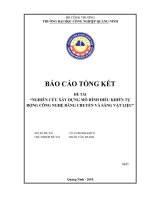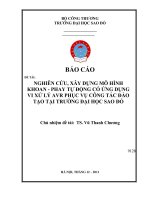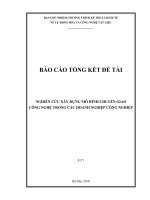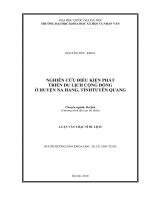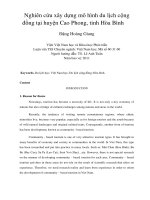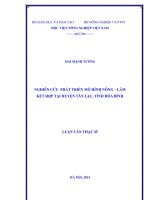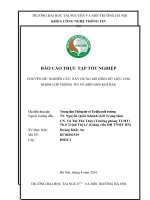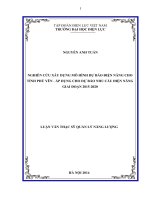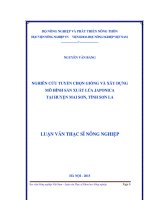Nghiên cứu xây dựng mô hình du lịch cộng đồng tại huyện cao phong, tỉnh hòa bình
Bạn đang xem bản rút gọn của tài liệu. Xem và tải ngay bản đầy đủ của tài liệu tại đây (281.11 KB, 8 trang )
Nghiên cứu xây dựng mô hình du lịch cộng
đồng tại huyện Cao Phong, tỉnh Hòa Bình
Đặng Hoàng Giang
Viện Việt Nam học và Khoa học Phát triển
Luận văn ThS Chuyên ngành: Việt Nam học; Mã số 60 31 60
Người hướng dẫn: TS. Lê Anh Tuấn
Năm bảo vệ: 2011
Keywords. Du lịch học; Việt Nam học; Du lịch cộng đồng; Hòa bình.
Content
INTRODUCTION
1. Reason for theme
Nowadays, tourism has become a necessity of life. It is not only a key economy of
nations but also a bridge of cultural exchanges among nations and areas in the world.
Recently, the tendency of visiting remote mountainous regions, where ethnic
minorities live, becomes very popular, especially as for foreign tourists and the youth because
of wild natural landscapes and original cultural traits. Consequently, another from of tourism
has been development, known as community - based tourism.
Community - based tourism is one of very attractive tourism types. It has brought in
many benefits of economy and society to communities in the world. In Viet Nam, this type
has been researched and put into practice in many locals. Such as: Mai Chau (Hoa Binh), Ba
Be (Bac Can), Sa Pa (Lao Cai), Suoi Voi (Hue)…ete. However, there is not special research
on the manner of developing community – based tourism for each area. Community – based
tourism activities in these areas do not rely on the result of scientific research that relies on
experience. Therefore, we need research reality and learn from experience in order to orient
the development of community – based tourism in Viet Nam.
Community – based tourism in Hoa Binh has been developed for a long time. The
most typical is community – based tourism model in Mai Chau. The tourism operations in
Mai Chau relies exploring culture tradition of Thai ethnic. During the tourism activities
develop has been an inadequate problem such as adverse effect on culture tradition of local,
pollution of environment…etc.
The same Mai Chau, Cao Phong district, Hoa Binh province, has many tourism
resources. Among them community - based tourism relies on exploring culture of ethnic
minorities in Giang Mo - the most typical village. This is the main residential area of Muong
people (one of the four major area of Muong) with traditional cultural values. The tourism
activities at Giang Mo has been beginning and developing since 1980s. Giang Mo village has
become an attractive destination. However, the tourism operation there has not been managed
effectively to meet its potentials. Thus, in the current tourism tendency, studying and
expanding the community - based tourism in Giang Mo are very important.
In order to improve tourism operations in Cao Phong, it’s necessary to study tourism
potentiality as well as reality of the district. From that, we can design and build the suitable
model. For these reasons, the researcher decided to carry out an investigation into the issue
titled: “Research on building models of community - based tourism (Case study of Giang Mo
village, Cao Phong district, Hoa Binh province)”.
2. Aims and objectives
Aims: orientate to building community - based tourism model in Cao Phong district,
Hoa Binh
Objectives:
- To systematize theoretical issues about community - based tourism
- To analyze experience in developing community tourism in Maichau and some other
locals in Viet Nam
- To analyze evaluate developing community tourism in Cao Phong
- To compare model community - based tourism of Lac village to bring out
community based model in Cao Phong
3. History of the research problem
There were a great number of scientific studies on community - based tourism
such as:
“Community - based tourism for Conservation and Development” book published in
2003 by The Mountain Institute (America). The authors have given concept, role and
motivation factors of community tourism. The authors have also presented some of
community tourism models in the South America and Malaysia. Then, they presented
knowledge, skills and experiences about community tourism.
“Community - based tourism – theory and use” (volume 1) book, PhD. Vo Que
(2006). The author presented community based tourism theory (concept, aim, condition,
signification, principle and criterion of community based tourism). Beside, the author also
researched some community based tourism models in Asia and Viet Nam. However, he did
not present concrete conditions and model.
"Sustainable tourism" book was published in 2001 of Nguyen Dinh Hoe and Vu Van Hieu.
The researchers thought that local community is an important in development of community based
tourism. However, they did not concern with factors of community based tourism for localities in
Viet Nam.
"Tourism with problems of ethnic minorities in Sa Pa" book was published in 2000 of
Pham Thi Mong Hoa and Lam Thi Mai Lan. The researchers presented the influence of
tourism on local ethnics in Sapa district, Laocai province. Throughout, the researchers put
forward solutions to minimize negative impact and enhance benefits for local communities in
tourism activities.
PhD Pham Le Thao’s “To organize the territory of Hoa Binh in opinion of sustainable
development” (2006). The author analyzed, evaluated and synthesized the factors of Hoa
Binh’s arrangement and development. In thesis, the author mentioned the development of
community based tourism in Giang Mo.
MA Nguyen Thi Hong Van’s “The effect of tourism on cultural – society of Thai
ethnic in Maichau district, Hoa Binh province and development solutions” thesis (2007). The
researcher studied the influence of tourism on Thai people’s economy, cultural, society in Mai
Chau. Since then, the author put forward the orientation sustainable development for
community based tourism in Mai Chau.
4. Subject and scope of the research
- Subject of research: community - based tourism form and development conditions of
community - based tourism.
- Scope of content: community relies on exploiting ethnic minorities’ culture.
- Scope of space: Cao Phong district, with the Giang Mo village is focused to research
Maichau district, with Lac village is comparison subjects.
- Scope of time: information and data collected from 2005 to 2010.
5. Research Methodology
Researcher used 6 methods of scientific research: Researching synthesis theory,
comparative approach, methods of sociological investigation, observation, questionnaire
method, methods of analysis and synthesis.
Research resources:
- Books and textbooks
- Newspapers, journals and magazines related content
- The scientific work such as reports, theses
- Report of the local governments and state agencies on tourism.
- Information and articles on the internet.
6. The layout of the thesis
Besides the introduction, conclusion, addendums, references, the thesis includes three
chapters as followings:
Chapter 1: Theoretical basis and reality of community - based tourism
Chapter 1 presents theoretical basics, concepts of community - based tourism,
principles and conditions of community - based tourism. Concurrently, chapter 1 also
provides some experience about community - based tourism in Viet Nam and other countries.
Chapter 2: Current situation of the community-based tourism development
operations in Hoa Binh prefecture
Chapter 2 presents the conditions for tourism development in Hoa Binh. The chapter
also introduces community - based tourism model in Lac village, Maichau district. The
conditions and reality of development tourism operation in Giang Mo village include: the
conditions about natural resources, local residents, infrastructure and technical material, the
policies and support. The researcher assesses advantages and disadvantages of community -
based tourism model in Lac village. Thenceforth, the researcher orients of building
community - based tourism in Giang Mo village.
Chapter 3: Orientation of building models of community - based tourism in Cao
Phong district, Hoa Binh province
Chapter 3 presents tourism development orients Hoa Binh province and Cao Phong
district, puts forward solution development, determines model and gives some petitions in
order to exploit the conditions to develop community - based tourism in Cao Phong.
REFERENCES
1. Lê Huy Bá, Thái Lê Nguyên (2006), Du lịch sinh thái, NXB Khoa học và Kỹ
thuật.
2. Công ty cổ phần thông tin kinh tế đối ngoại (2006), Hòa Bình thế và lực mới
trong thế kỉ XXI, NXB Chính trị quốc gia.
3. Đảng bộ tỉnh Hòa Bình, Huyện ủy Cao Phong (2010), Văn kiện Đại hội XXVI,
nhiệm kì 2010 - 2015
4. Thế Đạt (2005), Tài nguyên du lịch, NXB Chính trị quốc gia.
5. Phạm Thị Mộng Hoa, Lâm Thị Mai Lan (2000), Du lịch với dân tộc thiểu số ở
Sa Pa, NXB Văn hóa dân tộc.
6. Nguyễn Đình Hoè, Vũ Văn Hiếu (2001), Du lịch bền vững, NXB ĐH Quốc
gia Hà Nội.
7. Hội đồng khoa học kỹ thuật – Tổng cục du lịch (2009), Bản tin du lịch, quý
IV, Trung tâm Thông tin du lịch (Tổng cục du lịch).
8. Hội đồng khoa học kỹ thuật – Tổng cục du lịch (2010), Bản tin du lịch, quý I,
Trung tâm Thông tin du lịch (Tổng cục du lịch).
9. Nguyễn Văn Huy (1998), Bức tranh văn hóa các dân tộc Việt Nam, NXB Giáo
dục.
10. Phòng văn hóa và thông tin huyện Cao Phong (2009), Báo cáo tình hình hoạt
động kinh doanh của các đơn vị nhà nghỉ đóng trên địa bàn huyện Cao Phong ;
Tổng doanh thu, số lượt khách quốc tế, khách nội địa năm 2009.
11. Phòng văn hóa và thông tin huyện Cao Phong (2010), Kế hoạch phát triển du
lịch huyện Cao Phong giai đoạn 2010 - 2015.
12. Võ Quế (2006), Du lịch cộng đồng lý thuyết và vận dụng, Tập 1, NXB Khoa
học và kĩ thuật.
13. Sở Văn hóa, Thể thao và Du lịch Hòa Bình (2008), Báo cáo Đánh giá hoạt
động du lịch năm 2006 - 2008, và phương hướng, nhiệm vụ năm 2009 – 2010
14. Trần Đức Thanh (2005), Nhập môn khoa học du lịch, NXB Đại học Quốc gia
Hà Nội.
15. Tổng cục du lịch (2005), Luật du lịch
16. Phạm Lê Thảo (2006), Tổ chức lãnh thổ du lịch Hoà Bình trên quan điểm phát
triển bền vững: LATS Địa lý: 62.31.95.01.
17. Lê Anh Tuấn (2008), Du lịch nông thôn - định hướng phát triển ở Việt Nam,
Tạp chí Du lịch Việt Nam (2/2008), tr.32 - 33, tr 71.
18. Lê Anh Tuấn, Đặng Hoàng Giang (2010), Để phát triển du lịch Cao Phong -
Hòa Bình, Tạp chí Du lịch Việt Nam (3/2010), tr.46 - 47.
19. Nguyễn Minh Tuệ, Vũ Tuấn Cảnh, Lê Thông, Phạm Xuân Hậu, Nguyễn Kim
Hồng (1999), Địa lý du lịch, NXB Thành phố Hồ Chí Minh
20. Trần Từ (1996), Người Mường ở Hòa Bình, Hội khoa học Lịch sử Việt Nam
21. Nguyễn Thị Hồng Vân (2007), Tác động của du lịch đến đời sống văn hóa - xã
hội của người Thái ở Mai Châu - Hòa Bình và các giải pháp phát triển, Luận
văn thạc sĩ, Trường ĐHKHXH&NV.
22. Bùi Thị Hải Yến (2006), Tuyến điểm du lịch Việt Nam, NXB Giáo dục
23. Bùi Thị Hải Yến, Phạm Hồng Long (2007), Tài nguyên du lịch, NXB Giáo dục
24. Ủy ban nhân dân tỉnh Hòa Bình (2005), Địa chí Hòa Bình, NXB Chính trị quốc
gia.
25. Ủy ban nhân dân tỉnh Hòa Bình (2010), Báo cáo Sơ kết 3 năm thực hiện Nghị
quyết số 11-NQ/TU ngày 21/8/2007 của Tỉnh ủy về phát triển du lịch tỉnh Hòa
Bình giai đoạn 2007 - 2010, định hướng đến năm 2015
26. Robert M. Davison, Roger W. Harris, Douglas R Vogel (2003), E-Commerce
for Community-Based Tourism in Developing Countries, The Mountain
Institute, Franklin, West Virginia, USA
27. Báo Hòa Bình điện tử (2010), Hang động Cao Phong - Một tiềm năng du lịch,
, cập nhật: Thứ năm, 4/11/2010, 5:06:17 Chiều
28. Ủy ban nhân dân tỉnh Hòa Bình, Cổng thông tin điện tử, Khu du lịch Bản
Mường - Giang Mỗ, , cập nhật: 15/12/2009, 13:54
29. Trọng Thủy, Dân tộc và phát triển, Phát triển du lịch gắn với bản sắc văn hóa,
, cập nhật : 24 tháng 12 năm 2009, 16 :22.
30. The Thailand Community Based Tourism Institute, What is Community based
Tourism?,
31. Seven Community-based Tours in Ethnic Minority Villages,
32. The Northern Thailand Community Based Tourism Network Coordination
Center (CBT-N), Baan Huai Hee,
